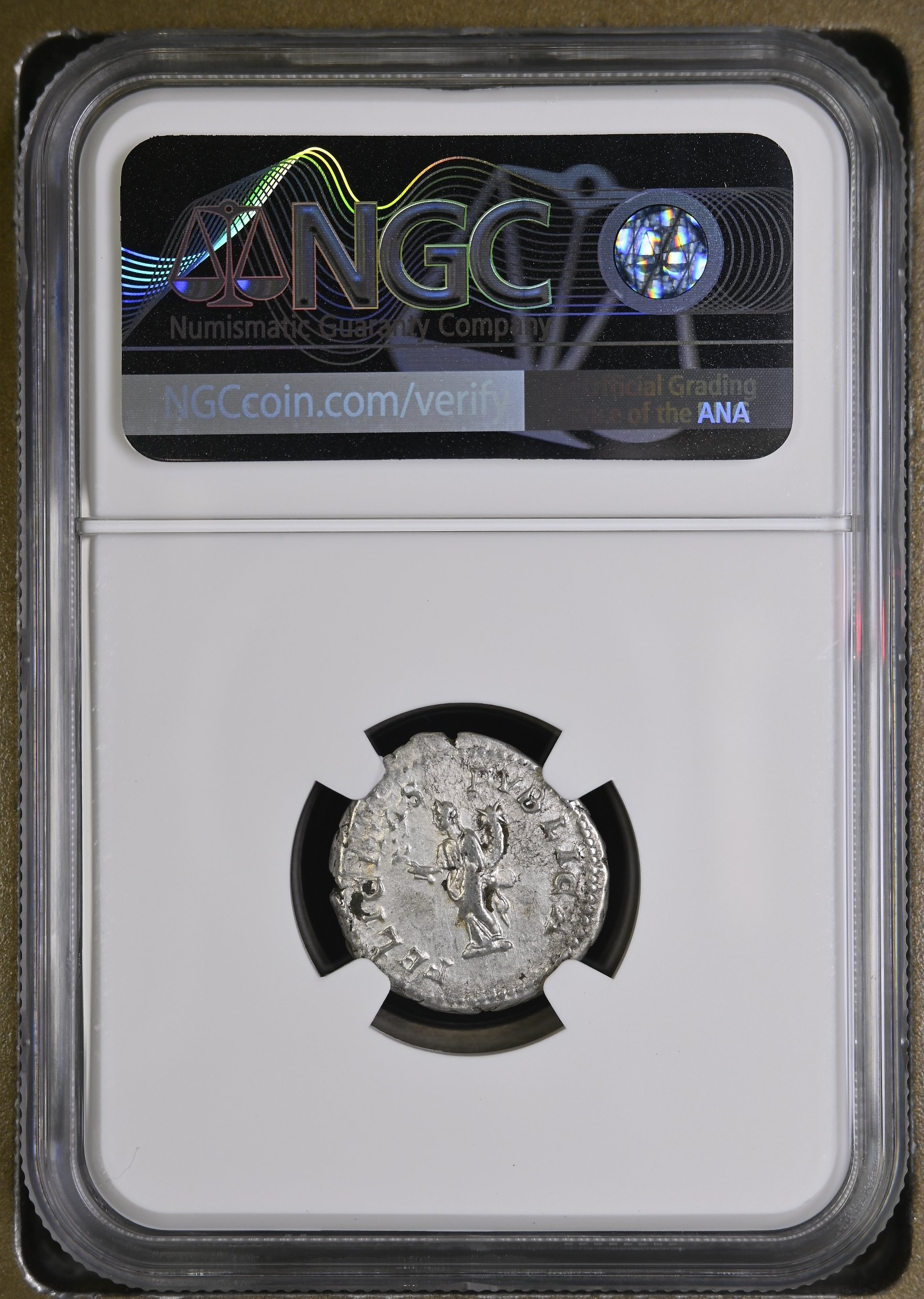 Image 1 of 2
Image 1 of 2

 Image 2 of 2
Image 2 of 2



This silver denarius features Emperor Caracalla, born Lucius Septimius Bassianus and later renamed Marcus Aurelius Antoninus, who ruled the Roman Empire first jointly with his father Septimius Severus
This silver denarius features Publius Septimius Geta, the younger son of Emperor Septimius Severus, during his time as Caesar (junior emperor) before becoming full Augustus. Minted between 209-211 CE, this coin represents the brief period when Geta held the title of Caesar while his father and older brother Caracalla were the senior rulers.
Coin Description:
Front side: The obverse shows the bare-headed bust of young Geta facing right, likely with the Latin inscription identifying him as P SEPT GETA CAES (Publius Septimius Geta Caesar) or similar titles.
Back side: Though not specified, the reverse would typically feature Roman deities, personifications of virtues, or symbols of imperial power appropriate for a junior emperor, with accompanying Latin inscriptions.
Technical Details:
Silver composition (AR)
Denarius denomination (standard silver coin of the Roman monetary system)
Weight: Approximately 3-3.5 grams
Size: Approximately 18-20mm in diameter
NGC Grade: Ch VF (Choice Very Fine) - indicating better than average preservation with moderate wear
Date of minting: 209-211 CE (during Geta's time as Caesar)
Historical Significance: Geta was elevated to Caesar by his father Septimius Severus as part of a plan to establish a stable dynasty. After his father's death in 211 CE at Eboracum (modern York, England), the intense rivalry between Geta and his brother Caracalla ended with Geta's murder in his mother Julia Domna's arms. Caracalla subsequently enacted a damnatio memoriae (condemnation of memory), ordering Geta's name removed from monuments and his coins recalled and melted, making surviving examples historically significant.
This silver denarius features Publius Septimius Geta, the younger son of Emperor Septimius Severus, during his time as Caesar (junior emperor) before becoming full Augustus. Minted between 209-211 CE, this coin represents the brief period when Geta held the title of Caesar while his father and older brother Caracalla were the senior rulers.
Coin Description:
Front side: The obverse shows the bare-headed bust of young Geta facing right, likely with the Latin inscription identifying him as P SEPT GETA CAES (Publius Septimius Geta Caesar) or similar titles.
Back side: Though not specified, the reverse would typically feature Roman deities, personifications of virtues, or symbols of imperial power appropriate for a junior emperor, with accompanying Latin inscriptions.
Technical Details:
Silver composition (AR)
Denarius denomination (standard silver coin of the Roman monetary system)
Weight: Approximately 3-3.5 grams
Size: Approximately 18-20mm in diameter
NGC Grade: Ch VF (Choice Very Fine) - indicating better than average preservation with moderate wear
Date of minting: 209-211 CE (during Geta's time as Caesar)
Historical Significance: Geta was elevated to Caesar by his father Septimius Severus as part of a plan to establish a stable dynasty. After his father's death in 211 CE at Eboracum (modern York, England), the intense rivalry between Geta and his brother Caracalla ended with Geta's murder in his mother Julia Domna's arms. Caracalla subsequently enacted a damnatio memoriae (condemnation of memory), ordering Geta's name removed from monuments and his coins recalled and melted, making surviving examples historically significant.
This silver denarius features Publius Septimius Geta, the younger son of Emperor Septimius Severus, during his time as Caesar (junior emperor) before becoming full Augustus. Minted between 209-211 CE, this coin represents the brief period when Geta held the title of Caesar while his father and older brother Caracalla were the senior rulers.
Coin Description:
Front side: The obverse shows the bare-headed bust of young Geta facing right, likely with the Latin inscription identifying him as P SEPT GETA CAES (Publius Septimius Geta Caesar) or similar titles.
Back side: Though not specified, the reverse would typically feature Roman deities, personifications of virtues, or symbols of imperial power appropriate for a junior emperor, with accompanying Latin inscriptions.
Technical Details:
Silver composition (AR)
Denarius denomination (standard silver coin of the Roman monetary system)
Weight: Approximately 3-3.5 grams
Size: Approximately 18-20mm in diameter
NGC Grade: Ch VF (Choice Very Fine) - indicating better than average preservation with moderate wear
Date of minting: 209-211 CE (during Geta's time as Caesar)
Historical Significance: Geta was elevated to Caesar by his father Septimius Severus as part of a plan to establish a stable dynasty. After his father's death in 211 CE at Eboracum (modern York, England), the intense rivalry between Geta and his brother Caracalla ended with Geta's murder in his mother Julia Domna's arms. Caracalla subsequently enacted a damnatio memoriae (condemnation of memory), ordering Geta's name removed from monuments and his coins recalled and melted, making surviving examples historically significant.
Publius Septimius Geta (/ˈɡɛtə/ GHET-ə; 7 March 189 – 26 December 211) was Roman emperor with his father Septimius Severus and older brother Caracalla from 209 to 211. Severus died in February 211 and intended for his sons to rule together, but they proved incapable of sharing power, culminating with the murder of Geta in December of that year.
Geta was the younger son of Septimius Severus by his second wife Julia Domna. He was born on 7 March 189[1][2] in either Rome or Mediolanum,[3][4] at a time when his father was only a provincial governor at the service of Emperor Commodus. On 28 January 198, Geta was raised to caesar (heir).[1] Septimius Severus gave him the title of augustus (emperor) in late 209,[5] perhaps in September or October.[6]























